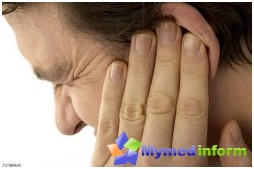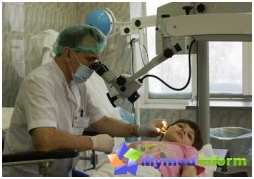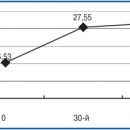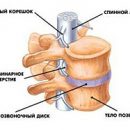Reducing the quality of hearing is not the only symptom of the disease: a person is repulsing the noise and pain in the ear, dizziness and neurasthenia. Are there any chances of recovery?
Why appears otosclerosis

Most often, the diagnosis of disappointing diagnosis is made by women aged 20 to 35 years. Why the disease amazes the beautiful floor in the heyday, it is reliably unknown. As a rule, Otosclerosis is striking at first one ear, and, slowly developing, passes later on the second. This may happen even in a few years. The status of a patient with otosclerosis of a woman can be significantly aggravated due to pregnancy. Thus, during the first pregnancy, the disease strongly progresses in 33% of future mothers, with the second - in 60%, and at the third - 80%.
There are several assumptions about possible factors provoking development Headups. Hereditary theory leads among them: very often the disease is familylike. In addition, 40% of people suffering from otoklerosis detect various genetic pathologies.
Considering that in patients with otoklerosis of pregnant women, health conditions deteriorate significantly, scientists suggest that changes occurring with an endocrine system and metabolism at this time, a certain way affect the development of the disease.
Types of disease

Gradually, the disease is gaining momentum, and then perception is disturbed not only low, but already high sounds. At the moments when the symptoms of the otosclerosis are especially pronounced, the patient is extremely difficult to understand the whisper, the perception of ordinary speech is also given to him with difficulty.
Disappointing fact: when releasing the regression of hearing loss is impossible, only its gradual exacerbation is observed. On the rapid development of hearing loss can affect the overall overwork of the body, as well as serious endocrine restructuring, among which the baby is tooling, the process of its appearance and menstruation itself. A characteristic feature of the disease is the drop in the quality of hearing up to 3 degrees of hearing loss, despite the fact that the complete deafness never comes.
On the «strange» Noise in the ears (or only in one ear) complains up to 80-83% of people suffering from otoklerosis. Describing your feelings, patients note that sounds constantly hear, very similar to the noise of foliage or work of primus. Doctors call this phenomenon with white noise. In trying to explain its origin, scientists agree that the wines of the whole violation in the snail circulatory and metabolic nature.
If the course of the disease occurs without exacerbations, the ear affected in the patient does not hurt. However, in complications of the otosclerotic process, the region of the deputyid process of the ear covers the painful sensations of the suspension. Unfortunately, the appearance of pain says that hearing will soon decrease even more. Dizziness in people suffering from otoklerosis practically does not happen. If something like this is observed, then these sensations are not strong and quickly disappear. If the hearing loss is extremely expressed, the doctor may assume the other origin (congenital syphilis, for example).
Neilstation in patients with otosclerosis develops on the basis of the lack of full-fledged communication due to the fact that it is difficult for them to perceive the speech. Poorly hearing man is constantly tense, so it's trying once again with anyone. As a result, it becomes very closed and apathetic. Patient Muchit insomnia, Therefore, during the day he drone and bad. Neurasthenic syndrome is present in almost all cases that are accompanied by extremely pronounced white noise and a strong decrease in the quality of hearing.
Diagnosis of the disease

Noise in the ear - the first of the complaints that hear the otolaryngologist from a person with suspicion of otoklerosis. The task of the doctor includes distinguish this disease from the symptoms of other diseases like it. Among them, for example, adhesive average otitis, chronic purulent otitis, sulfur tube, ear tumor, etc. For differentiation of otosclerosis, a thorough study of the ear and the otoscopy is carried out. In the process of the audiometry, problems with the perception of speech at the level of the whisper. If the patient is overcoming the ear and dizziness, it will take a survey at the detonation and a vestibular. Using aiming radiography, skulls reveal disorders in the bone of the labyrinth capsule.
Treatment of otosclerosis
Correct otoklerosis by surgical methods of treatment, which pursue the improvement of the transmission of sound oscillations from a number of auditory bones to the labyrinth perilimph.

MirSoveto notes that the operation is relevant if the reduction of sound conductivity stands at a not lower than 25 dB, and the air - not higher than 50 dB. But if the otosclerosis is in the active stage of development or complicated by anything, the operational intervention is postponed indefinitely.
Surgical treatment of otosclerosis involves 3 types of surgical intervention: mobilization of the aspirations, fenestration of the labyrinth and staped plastic.
The mobilization of the stupid is aimed at its release from the syllable bone battles, fenestration - on the formation of a new window on the eve of the labyrinth. Unfortunately, the operations bring only a short-term result, and a few years after visible improvement, the hearing thoughts progresses again. The most effective consider staped plastic, during which the prosthesis is placed in place. Operate the ear that hears worse. If the operation has been successful, the re-interference for the correction of hearing on the second ear is possible after 5-6 months. In 80% of cases, this operation provides a patient a stable improvement in the quality of speech perception.









